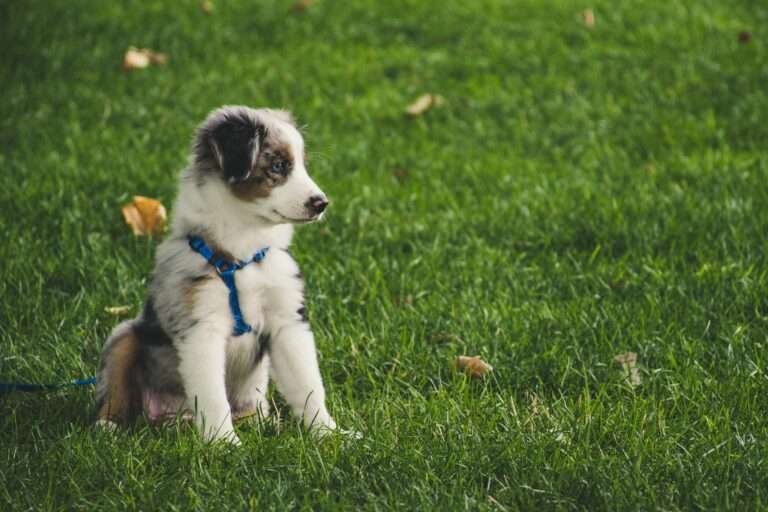How to Toilet train a Puppy
How to House Train a Puppy
Introduction
House training a puppy is a crucial aspect of bringing a new dog into your home. It’s an important step in establishing a clean living environment and ensuring your puppy grows into a well-behaved dog.
Many new pet owners face challenges during this process, ranging from frequent accidents to understanding the pup’s cues.
This article aims to navigate these challenges, offering a comprehensive guide to effectively house train your puppy.

We’ll look at puppy development, preparing your home, establishing routines, positive reinforcement techniques, tackling common challenges, night-time and crate training, and when to seek professional help, ensuring a smooth transition for your puppy from untrained to understanding what is wanted from it.
Understanding Puppy Development
Stages of Puppy Development Relevant to House Training
Puppy development is a journey filled with rapid changes, crucial for house training. Puppies go through several developmental stages, starting from the neonatal period, transitioning into the socialisation phase at about three to twelve weeks, and then into the juvenile stage. During these stages, puppies learn about their environment, social cues, and start to understand basic commands, making it a prime time for initiating house training.
Puppy’s Age and Bladder Control
A key factor in house training is the puppy’s age, as it directly impacts their bladder and bowel control. Puppies typically gain better control over their bladder and bowels at around 12-16 weeks. Understanding that younger puppies need more frequent toilet breaks is essential for a successful training regimen.
Importance of Early Training and Routine Setting
Starting house training early is crucial. Introducing puppies to a routine not only helps in quicker adaptation but also instils a sense of security and predictability. Early training includes setting specific times for feeding, playing, and toilet breaks, which helps the puppy in associating certain times of the day with these activities, paving the way for successful toilet training.
Preparing Your Home for House Training
Creating a Designated Toilet Area for the Puppy
Selecting and consistently using a designated toilet area is pivotal for effective house training. Whether it’s a specific corner of the garden or a puppy pad inside the home, consistency is key. The area should be easily accessible for the puppy and maintained in a clean, inviting state to encourage its use.
Puppy-Proofing Your Home to Prevent Accidents
Puppy-proofing is not just about safety; it’s also about reducing the likelihood of accidents. Remove or protect valuable items and furnishings from potential puppy accidents. Remove anything that dangles and could cause a hanging accident, and ensure no electrical cables are accessible to the puppy. Ensuring that the floors are easy to clean and removing rugs or carpets can also help in managing the inevitable mishaps during the training process.
Essential Supplies for Effective House Training
Having the right supplies can significantly ease the house training process. Essentials include:
- Puppy Pads: Useful for indoor training, especially for young puppies who cannot go outside yet.
- Enzymatic Cleaners: These are crucial for cleaning up accidents, as they effectively break down odours and stains, discouraging the puppy from returning to the same spot.
- Treats: For rewards during training.
- Crate: A helpful tool for creating a safe and controlled environment for your puppy.
- Training Clicker: If you want to begin clicker training at this stage.

Establishing a Routine
Creating a consistent routine is essential for successful house training. A structured schedule not only helps with toilet training but also instills a sense of security and predictability in your puppy. Here’s how to go about it:
Consistent Schedule for Feeding and Toilet Breaks
Maintain a regular feeding schedule, as this directly influences your puppy’s toilet habits. Generally, puppies need to relieve themselves shortly after eating, so plan their toilet breaks accordingly. Consistency in feeding times leads to regularity in toilet habits.
Recognising Signs Your Puppy Needs to Go
Puppies often show signs when they need to toilet. These include sniffing the ground, circling, whining, or going to the door. Being attentive to these cues is crucial for timely and successful toilet breaks.
Techniques for Encouraging Toilet Area Use
Consistently leading your puppy to the designated toilet area and using a command like “go potty” helps them associate the area with the act. Reward them immediately after they’ve done their business to reinforce the behaviour.
Sample House Training Schedule
| Time | Activity |
| 7:00 AM | Wake up and toilet break |
| 7:30 AM | Breakfast |
| 8:00 AM | Toilet break |
| 12:00 PM | Lunch and toilet break |
| 3:00 PM | Afternoon toilet break |
| 6:00 PM | Dinner and toilet break |
| 8:00 PM | Evening playtime/toilet |
| 10:00 PM | Last toilet break before bed |
This schedule is a general guide and should be adjusted according to your puppy’s specific needs and habits. The key is regularity and consistency.
Positive Reinforcement and Training Techniques
Principles of Positive Reinforcement in Training
Positive reinforcement involves rewarding desired behaviours to encourage the dog to repeat them. It’s a powerful method in puppy training, fostering a positive relationship between you and your puppy. The principle is simple: reward the behaviour you want to see.
Step-by-Step Guide to Rewarding Good Behaviour
- Identify the Desired Behaviour: Choose a specific behaviour you want to encourage, like toileting in the designated area.
- Choose the Right Reward: This could be treats, praise, or playtime – whatever motivates your puppy.
- Timing is Key: Reward your puppy immediately after the desired behaviour. This helps them make a clear connection between the action and the reward.
- Be Consistent: Consistently reward the behaviour every time it occurs to reinforce the learning.
- Gradually Reduce Treats: As the behaviour becomes more consistent, gradually reduce treats and replace them with verbal praise or petting and playing.
Addressing and Correcting Accidents Without Punishment
- Stay Calm: If you catch your puppy in the act, calmly interrupt them and take them to the designated toilet area.
- Clean Up Thoroughly: Use an enzymatic cleaner to remove odours that might attract the puppy back to the spot.
- Avoid Punishment: Punishing your puppy for accidents can lead to fear and confusion. It’s more effective to focus on reinforcing the correct behaviour.
Common House Training Challenges and Solutions
House training isn’t always smooth sailing. Here are some common challenges and how to address them:
Dealing with Frequent Accidents and Setbacks
- Review the Routine: Ensure your puppy’s feeding and toilet break schedule is consistent.
- Supervision and Confinement: Keep a close eye on your puppy, or use a crate when unsupervised to prevent accidents.
Adjusting the Training Approach for Different Breeds and Temperaments
- Understand Breed Specifics: Some breeds may require more patience or different approaches.
- Tailor the Training: Adjust the training method to fit your puppy’s unique personality and learning style.
House training a puppy demands patience, consistency, and understanding. Each puppy is unique, and what works for one may not work for another. Remember, persistence and positive reinforcement are your best tools.
Night Time Training and Crate Training
Tips for House Training Your Puppy at Night
- Last Toilet Break: Ensure your puppy has a toilet break right before bedtime.
- Limit Water Intake: Reduce water intake an hour or two before bed to decrease the likelihood of overnight accidents.
- Comfortable Sleeping Area: Ensure the puppy’s sleeping area is comfortable, encouraging them to stay and sleep through the night.
- Respond to Night-Time Whining: If your puppy whines during the night, they may need a toilet break. Keep the outing quiet and uneventful, then straight back to bed.
Introduction to Crate Training and Its Benefits for House Training
Crate training can be an effective tool in house training, as it taps into the puppy’s natural instinct not to soil their sleeping area. It helps in establishing a routine, provides a safe space for the puppy, and prevents accidents when you can’t supervise.
How to Make the Crate a Comfortable Space for Your Puppy
- Choose the Right Size: The crate should be big enough for your puppy to stand, turn around, and lie down comfortably.
- Introduce Gradually: Start by placing treats and toys in the crate, allowing the puppy to explore at their own pace.
- Associate the Crate with Positive Experiences: Feed meals in the crate and provide treats when the puppy enters willingly.
- Comfortable Bedding: Add comfortable bedding and perhaps a toy for comfort.
- Avoid Using the Crate for Punishment: The crate should always be associated with positive experiences.
Crate training, when done correctly, can significantly ease the house training process, offering a structured, secure environment for your puppy. It’s important to remember that crate training is a gradual process requiring patience and consistency.
When to Seek Professional Help
Recognising Persistent House Training Issues
Sometimes, despite your best efforts, house training may not progress as expected. Persistent accidents, signs of distress while toileting, or regression in trained puppies are indicators that professional help might be needed.
Options for Professional Training and Support
- Dog Trainers: Certified dog trainers can provide personalised guidance and strategies tailored to your puppy’s needs.
- Puppy Classes: These classes can help with socialisation and basic training, complementing your house training efforts.
Importance of Veterinary Consultation for Potential Medical Issues
If house training difficulties persist, it’s crucial to consult a vet. Certain medical conditions, such as urinary tract infections or gastrointestinal issues, can affect a puppy’s ability to control elimination. A veterinarian can rule out these concerns and ensure your puppy’s health isn’t the underlying cause of house-training challenges.
Understanding when to seek external help is vital in ensuring your puppy’s well-being and maintaining a positive, frustration-free training environment.
Long-term Maintenance and Consistency
Strategies for Maintaining House Training as Your Puppy Grows
- Stick to the Routine: Consistency in routine helps solidify house training habits.
- Gradual Adjustments: As your puppy matures, gradually adjust the schedule to suit their developing bladder control.
The Role of Consistency and Patience in Long-Term Success
Consistent reinforcement of house training principles and patience during the learning process are key to long-term success.
Transitioning from Puppyhood to Adulthood with Established Toilet Habits
As your puppy transitions to adulthood, maintain the training structure to ensure established habits remain firm. Regular exercise, continued routine, and positive reinforcement help in maintaining these habits.
Final Thoughts
House training a puppy is a journey filled with challenges and rewards. By understanding puppy development, establishing routines, using positive reinforcement methods, and addressing challenges with patience, you set the foundation for a well-trained dog. Remember, consistency, patience, and love are the cornerstones of successful house training. The bond and trust built during this process are invaluable.
Thanks for reading. If you have any tips or questions please leave a comment below – we’d love to hear from you.


